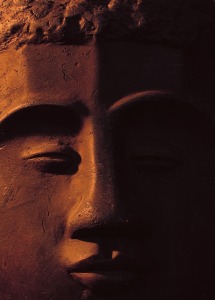Candomblé
Meeting the Orixás
 The african region Yorubá (sudanese people) is one of the main origin areas of the slaves deported to Brazil. As early as 1452 this region delivered slaves to the Portuguese. Together with the Yorubá slaves also their culture and the religion of the Orixás (deities, Orishas is often used in english) came to Brazil.
The african region Yorubá (sudanese people) is one of the main origin areas of the slaves deported to Brazil. As early as 1452 this region delivered slaves to the Portuguese. Together with the Yorubá slaves also their culture and the religion of the Orixás (deities, Orishas is often used in english) came to Brazil.The origin of the form of Candomblé practised nowadays, however, dates back to the 18th century; still today it is an inherent part of life in Brazil.
Especially in the federal state of Bahia many catholics can be observed sacrificing gifts to the deities of the Candomblé religion. The phenomenon of intermixing of Catholicism with African religions came about through the fact that the slaves were forced to become Christians - they did, however, not forget their usual deities but instead continued worshiping them in the form of catholic saints.
|
Every human being is linked to his Orixá from the day of his birth. The Orixás are spiritual beings, which as such cannot exist on the man-inhabited material level (Aiye). Their appearance is however facilitated by placing a human body at their disposal. The cult to achieve this consists of a series of rites, which are characterised by a certain structure. Every religious act must start with an animal sacrifice to Exú,
|
subsequently dancing and singing is performed around the sacrifice. After this, the other Orixás are called upon by percussion music, dance and song. To each deity belong its own music, its own rhythm, and special dancing steps. The cult facilitates direct access to the Orixá. The believer has the possibility to put his body at the Orixá's disposal, in this way both are reside in one body. |
In the following the worshipped deities are characterised:
| Exú | is the messenger of all Orixás. |
| Ogum | is the deity of iron, lord of the blacksmiths and peasants. He is equated with Holy Anthony. | Oxossi | is the deity of hunters and corresponds to Holy George. |
| Ossain | He is the god of herbs and medicine, his catholic correspondence is Holy Benedict. |
| Omolu | or Obaluae, is the deity of suffering and diseases, is compared to Holy Lazarus. |
| Nana | is the mother of Omolu and connected to earth. |
| Oxumaré | is the rainbow and corresponds to Holy Anne. |
| Xango | is the deity of fire, thunder, and of lightning. He corresponds to Holy Hieronymus. |
| Yansã | Similar to Xango, Yansã is associated with the natural forces of thunderstorms and is characterised especially by lightning and stormy wind. |
| Oxum | is the deity of freshwater, love and of fertility. |
| Yemanja | is the goddess of the sea and mother to other Orixas. |
| Ibeji | is the Orixá of children, of happiness and fun. | Oxala | Oxala is the son of the highest creator god Olorum. |
The pictures of the individual orixás shown here originate from the visual artist Francisco Santos from Salvador da Bahia.
| Sitemap | Afrobrazil |